
Original Link: https://www.anandtech.com/show/2247
Computex 2007: Hit the Road Jack!
by Gary Key and Jarred Walton on June 6, 2007 6:00 PM EST- Posted in
- Trade Shows
In our initial Computex preview article we focused primarily on motherboards and a few multimedia devices that we were shown. Most of the talk in the motherboard market currently centers around Intel's new P35 and upcoming X38 chipsets, although we have also seen a few AMD Barcelona servers as well as some NVIDIA chipset motherboards. We're going to leave additional coverage of motherboards for another day, as today we're taking a look at mobile devices.

In terms of raw performance, laptops are decidedly less sexy in the eyes of many enthusiasts. The main problem is that heat and power requirements are a major problem when you try to stuff a bunch of high performing parts into a small chassis. While there are certainly high-performance laptops available, the cost and performance offered is still at least a generation behind the latest desktop computers. The good news, naturally, is that the vast majority of people don't need quad core processors, 8GB of memory, and 8800 GTX SLI/HD 2900 XT CrossFire for their everyday computing needs.
Intel has recently released their Santa Rosa mobile platform that brings improved Front Side Bus speeds and power management to the Core 2 Duo product line. While our initial look at the platform didn't show a significant advantage relative to the earlier Napa platform, neither did it show any disadvantages. Santa Rosa will also add support for future Penryn based mobile processors, so provided prices are competitive and you can get all of the features you desire Santa Rosa is now our mobile platform of choice.
Intel isn't only one updating their mobile offerings. NVIDIA recently launched their GeForce 8 Series mobile parts, and AMD is also working on releasing their Radeon 2000 Series laptop offerings. Both of these bring DirectX 10 support to the latest laptops, along with support for full acceleration of HD video content. In our experience, laptop users are far more likely to watch movies using their computer than your typical desktop user -- if you're at home sitting in front of a computer watching a movie, wouldn't it be easier to just plunk down in front of your television instead? That being the case, Blu-ray/HD-DVD support in laptops along with a graphics chip that can accelerate the decoding process is something quite a few people are interested in seeing, and not surprisingly there were quite a few laptops on display that offered such features.
What about AMD's mobile platform? On the processor side of things, AMD has now started shipping 65nm Turion X2 processors, which will hopefully lower power requirements slightly, but we were told not to expect any significant performance improvement clock-for-clock relative to the 90nm parts. We will have to wait for the upcoming Griffin processors and the Puma platform before we see any other significant changes to the AMD mobile sector. Not surprisingly, there are far more Core 2 Duo laptops being demonstrated than Turion X2 laptops, but we did see at least one "all AMD" laptop on the show floor. Prices do tend to be a bit cheaper, however, so if all you're looking for is a decent entry level laptop then an AMD offering might be appropriate.
Now let's take a look at some of the latest trends in notebooks as we visited the Acer, ASUS, Gigabyte, and MSI booths.
Acer
Acer is a well-known manufacturer of notebooks and they had quite a few on display at their booth. Acer also offers AMD based laptops, but they weren't demonstrating anything new in that area that we saw. Here's a look at their latest Intel offerings.
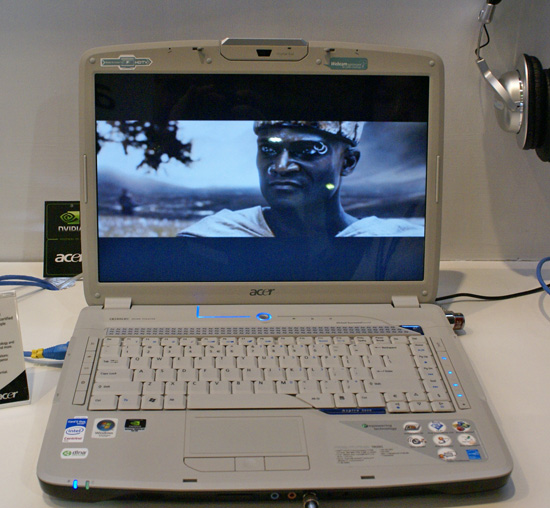
The Aspire 5920G is one of their latest offerings based off Intel's Santa Rosa platform. It includes GeForce 8600M GT graphics, making it a good fit as a portable media platform as well as providing adequate power for most modern games. The 15.4" display boasts an 8ms response time, and the laptop is one of the first to feature Dolby Home Theater enhanced sound courtesy of the integrated Music Note 5.1 speakers and subwoofer. An HD-DVD optical drive along with HDCP support and an HDMI port round out the noteworthy specifications, and an integrated webcam provides for easy videoconferencing.
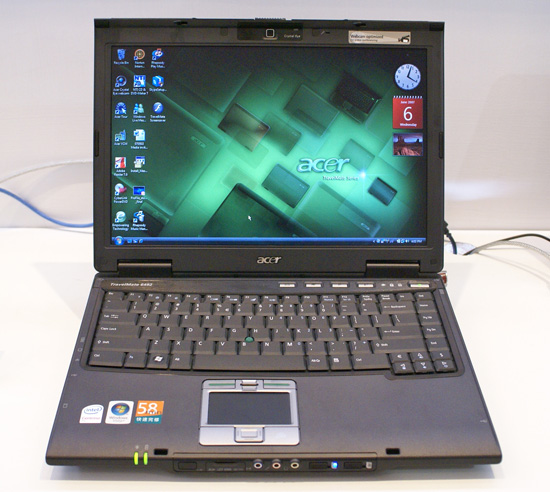
The TravelMate 6492 is more of a business oriented notebook, so it drops the discrete graphics and uses a 14.1" LCD. It also comes with a TPM module and fingerprint scanner for enhanced security. The 6492 is based off the new Intel Centrino Pro platform, which means the laptop also gets Wireless-N networking. The integrated Acer Crystal Eye webcam is apparently improved over other webcam offerings with optimizations that enable it to work better in low-light conditions for improved videoconferencing, and besides the standard trackpad Acer includes their FineTrack pointing device, similar to the Lenovo laptops. Finally, the laptop features support for Acer's ezDock II/II+ docking module.
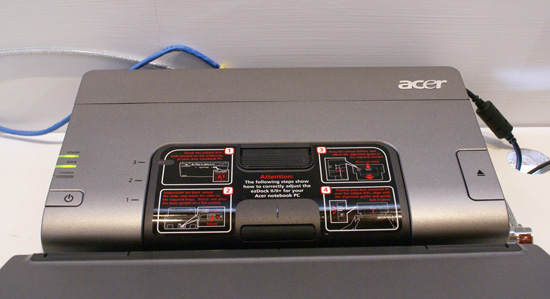
Acer's ezDock II/II+ offer up to 20 additional interfaces for support of laptops. You get serial and parallel ports, six more USB ports, 6-pin and 4-pin FireWire ports, VGA and DVI outputs, phone and networking support, a PS/2 mouse/keyboard port, and audio jacks including an S/PDIF port. Many of these interfaces are already present on the laptop itself, but some business users prefer the ease-of-use of a docking station.
ASUS
ASUS offers a complete line of laptops, all of which are based off of Intel platforms. They also had a couple of new features for their notebooks, besides updates to existing models.
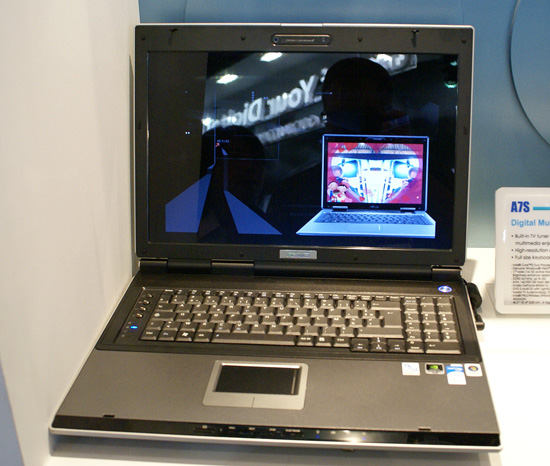
The ASUS A7S is billed as a "digital multimedia station" and like most of the laptops being showcased today it supports the latest 800FSB Core 2 Duo processors (T7100, T7300, T7500, and T7700). The 17.1" LCD features a native 1440x900 resolution and appears to be similar (if not identical) to the display that we liked so much on the ASUS G2P. Graphics are powered by NVIDIA's 8400M G with 128MB of graphics memory. Multimedia features are enhanced by an integrated TV tuner (analog + DVB-T) and Dolby Digital Live support, and an HDMI port is also present. Somewhat odd is that the A7S doesn't officially list HD-DVD or Blu-ray support, however.
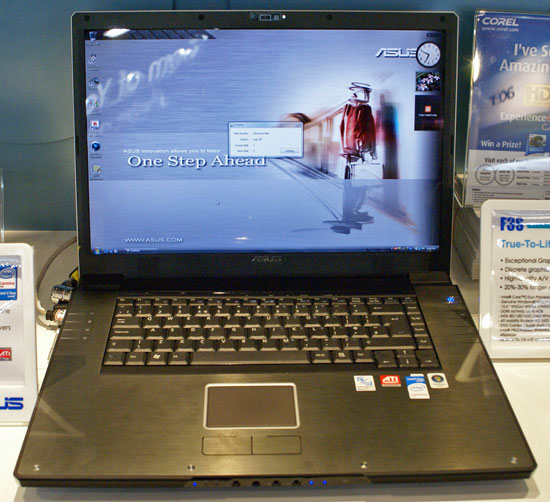
The W2W adds HD-DVD or Blu-ray support and drops down to Intel integrated graphics. It comes with a 17.0" SXGA+/WUXGA LCD, TV tuner, and a built-in subwoofer. The LCD also appeared to be one of the improved brightness models.
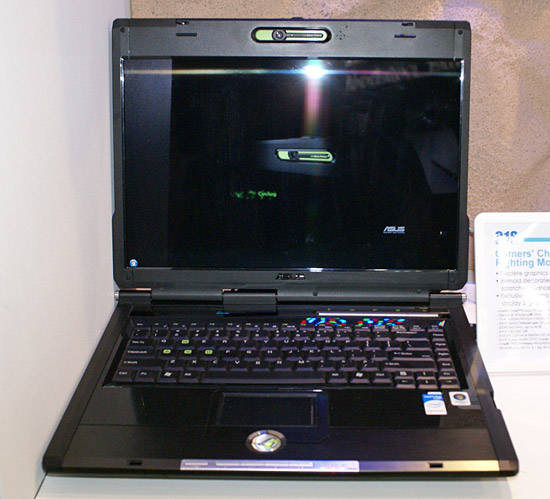
The G1S is more of a gamer notebook, with GeForce 8600M GT 256MB graphics and a 15.4" WSXGA+ (1680x1050) LCD. While the laptop is slightly smaller, the G1S is something of an update to the G2P and includes similar features such as the "gaming keyboard". We do appreciate the improved resolution of the LCD, but the brightness and overall quality appeared to be less than that of the G2P; however, unlike the Radeon Mobility X1700 graphics used in the G2P the 8600M GT is far better suited for gaming purposes. Optical drive options range from DVD Super-Multi/LightScribe to Blu-ray and HD-DVD models, although we would assume the latter two increase the price significantly.
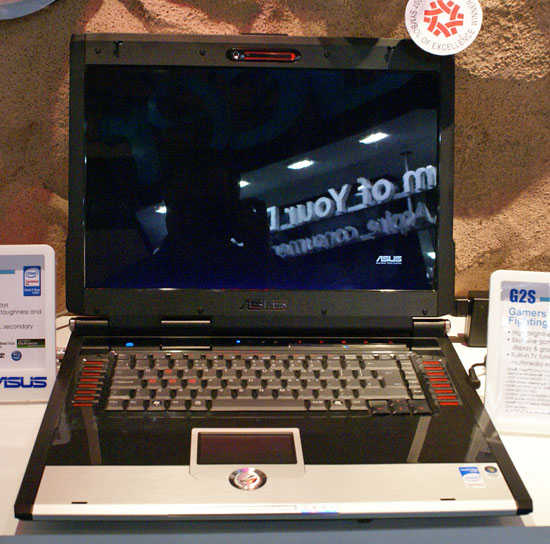
The G2S has nearly identical features to the G1S, only as the same 17.1" LCD as the G2P (with up to 2X the brightness of other laptop LCD panels), available in either WXGA+ or WUXGA format. Along with HD-DVD or Blu-ray support, it also adds a TV tuner and Dolby audio support, so users looking for a laptop with "the works" might find this combination of features to be better than the above to ASUS offerings.
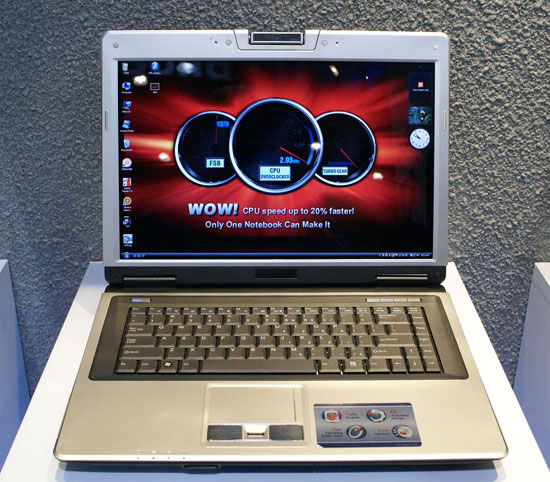
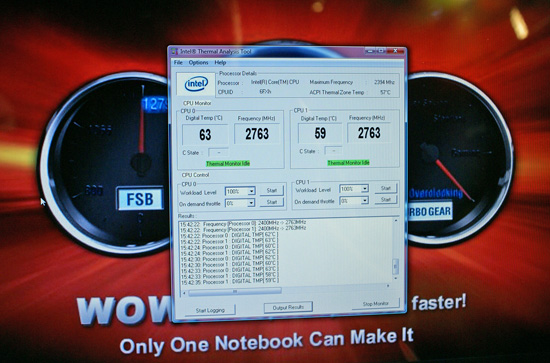
One of the new features from ASUS can be found in their top-performing P3S/C90S notebook. The front side bus can be overclocked up to 20%, and unlike most notebooks the C90S accepts standard socket 775 processors. At the booth they were demonstrating an E6600 running at 2.76 GHz.
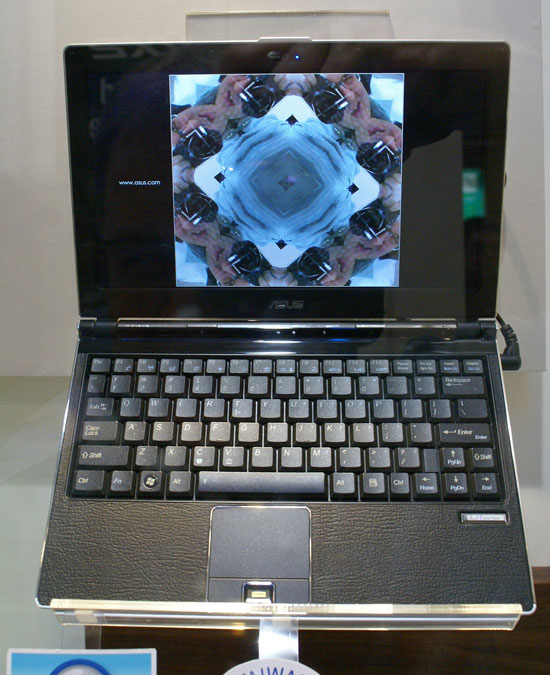
Another first from ASUS is an LED backlit laptop, the U1F. The LED backlighting looked great when we saw it, although the primary reason appears to be improved battery life and not necessarily better colors/brightness. To that end, the U1F includes a Core Duo U2400 CPU, a 12.1" display, and an ultraportable weight of 1 kg.
Gigabyte
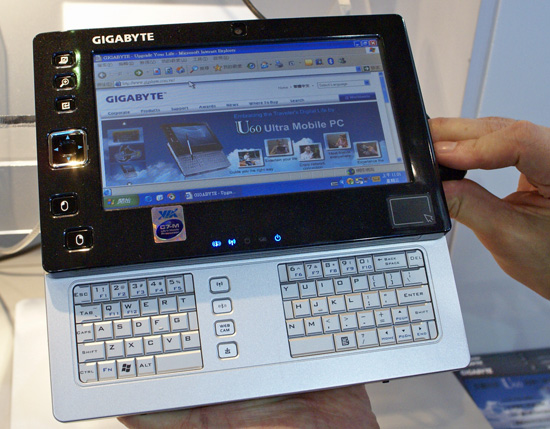
Gigabyte was very excited to show off their new UMPC, the U60. The U60 is equipped with Windows XP Professional or Home, is based on VIA's new Esther Mobile Technology with the VIA C7-M 1GHz CPU and VIA VX-700 UniChrome Pro II Graphics solution. It has 768MB of DDR2-533 on board, a 30GB Hard Drive, built in 802.11b/g WiFi, Media Card Slot support, an optional External ODD 8/4/8X DVD+/-RW or External 8/4/8/5X Super Multi DVD RW via a USB 2.0 connection, and a 6.5" Touch Screen LCD with an 800x480 resolution. The unit will cost around $800, compared with the $1000-$1500 most other UMPC's are currently going for at this time. The only drawback is the unit will not be imported into the US until Gigabyte has sufficiently tested it with the US based wireless Internet carriers such as Sprint and T-Mobile.
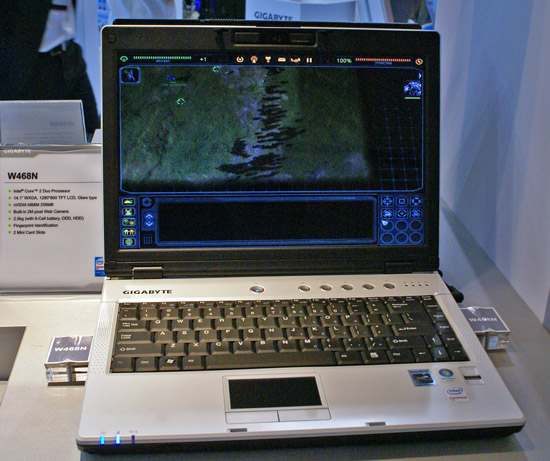
The W468N is a hybrid notebook that easily can suffice as your primary office notebook or can be used as a casual gaming system. The W468N is based on the Intel PM965 and ICH8-M chipsets, includes GeForce NB8M 256MB graphics and a 14.1" WXGA (1280x800) LCD. Processor choices are based on the Core 2 Duo 800FSB models with 2MB or 4MB of L2 cache with memory options featuring 4GB capacity with DDR2667/800 support. The unit can be equipped with hard drives ranging from 80GB to 160GB and has optional Robson support. Optical drive options range from DVD-RAM/R/RW combo to HD-DVD models with built-in network support for Gigabit LAN and 802.11 a/g/b wireless. The unit weighs 2.5 kg with battery and comes with a 2-year warranty. We expect availability within the next month.
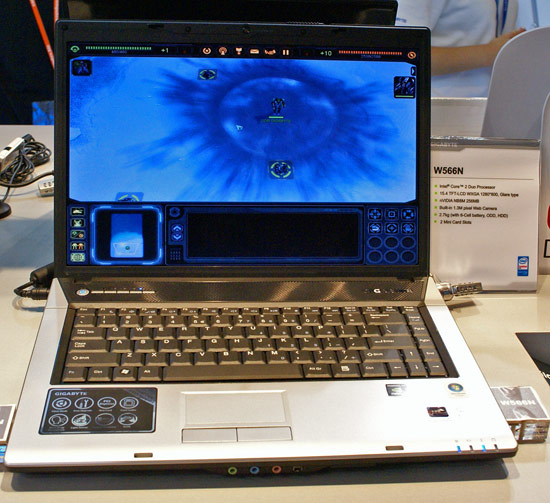
The W566N has nearly identical features to the W468N, only with a 15.4" LCD but still offering the same WXGA (1280x800) resolution. This model also has an optional built-in fingerprint identification system and features Dual-Heatpipe technology to ensure the system runs cool over the course of gaming or movie session. We think this notebook is probably best suited for the traveler who wants to play a game of Supreme Commander or watch their latest HD-DVD title on a trip.
MSI
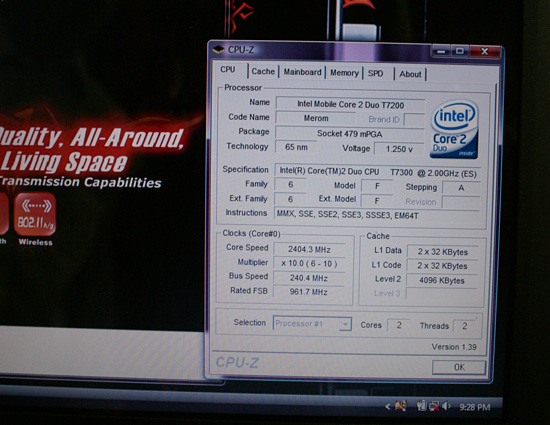
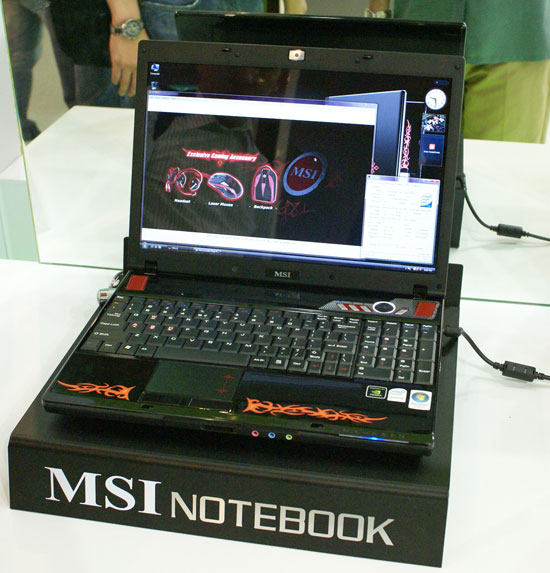
MSI follows ASUS in now offering overclocking support on one of their notebooks. The GX600 (MS-163A) features "Turbo" technology that will overclock the front side bus by 20%. Unlike the ASUS offering, however, MSI uses a standard mobile Core 2 Duo processor. They were demonstrating a T7200 overclocked to 2.4 GHz. The laptop also comes with GeForce 8600M GT 512MB graphics, 15.4" LCD, a webcam, a numeric keypad, and eSATA support. This was one of our favorite notebooks at the show after spending some additional hands-on time with it.
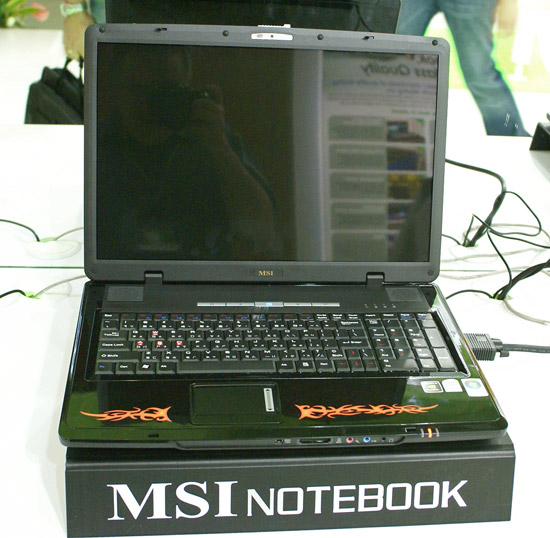
The GX700 (MS-1719) appears to be the big brother of the GX600, and it comes with a 17" LCD. It includes integrated 4.1 speakers, an optional integrated TV tuner, and HDMI output. Unfortunately, it appears to lack the overclocking functionality, but it does include a webcam and the same GeForce 8600M GT 512MB graphics.
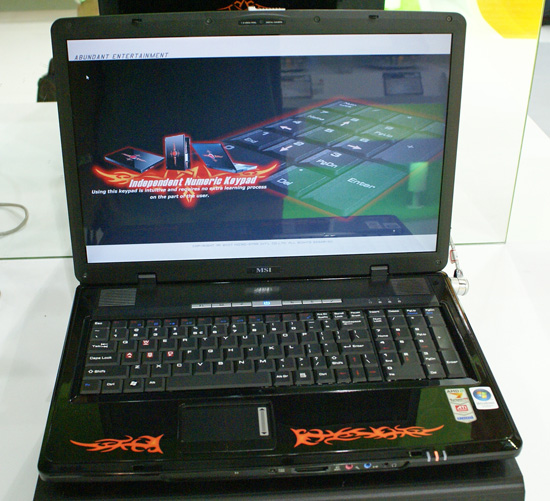
The external appearance of the GX710 (MS-171A) is nearly identical to the GX700, but inside the two are very different beasts. Like the GX700, the GX710 is based on a 17" chassis and includes 4.1 speakers, an optional TV tuner, and HDMI output. The big difference? The GX710 is a Turion X2 platform with a Radeon Mobility HD 2600 HyperMemory graphics chip. As we have not yet been able to test Radeon HD 2600 cards, we can't say whether the HD 2600 can outperform the GeForce 8600, but we will hopefully be able to answer that question in the not-too-distant future.
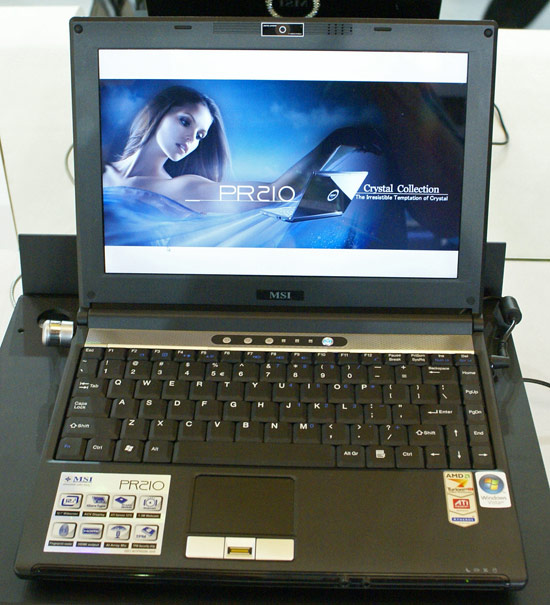
MSI was also showing their PR210 (MS-1222) laptop, a 12.1" ultraportable with integrated Radeon Xpress 1270 graphics. It also includes a TPM support and a fingerprint scanner, HDMI output, and a 1.3M webcam.
Day 2 Wrap-up
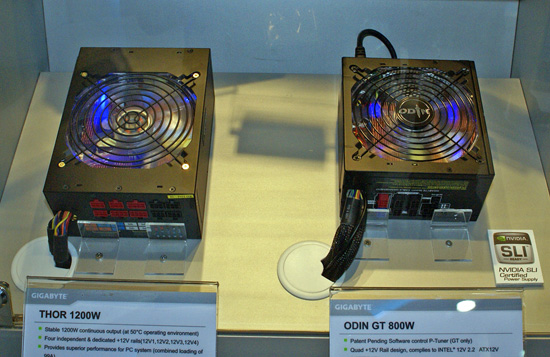
We focused on notebooks today, but there are other trends that we're seeing. Larger power supplies, for example, are commonplace. The Gigabyte power supplies shown above also include software that allows monitoring of the PSU load, temperatures, and fan speed.
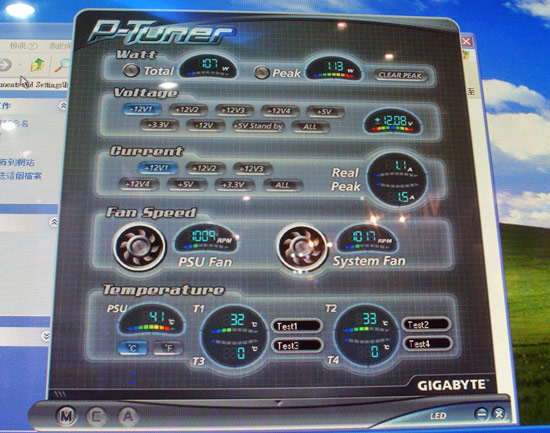
Having trouble figuring out what sort of system would require a 1200W power supply? Hopefully we'll be able to provide some answers by the end of the week. Needless to say, quad core processors with HD 2900 XT CrossFire or GeForce 8800 GTX SLI can certainly draw a lot of power, and with octal core computers like Intel's V8 and the upcoming Barcelona 2S systems, perhaps 1200W isn't entirely overkill? Just make sure that your house's wiring is up to snuff! Stay tuned for continuing coverage from Computex 2007.







